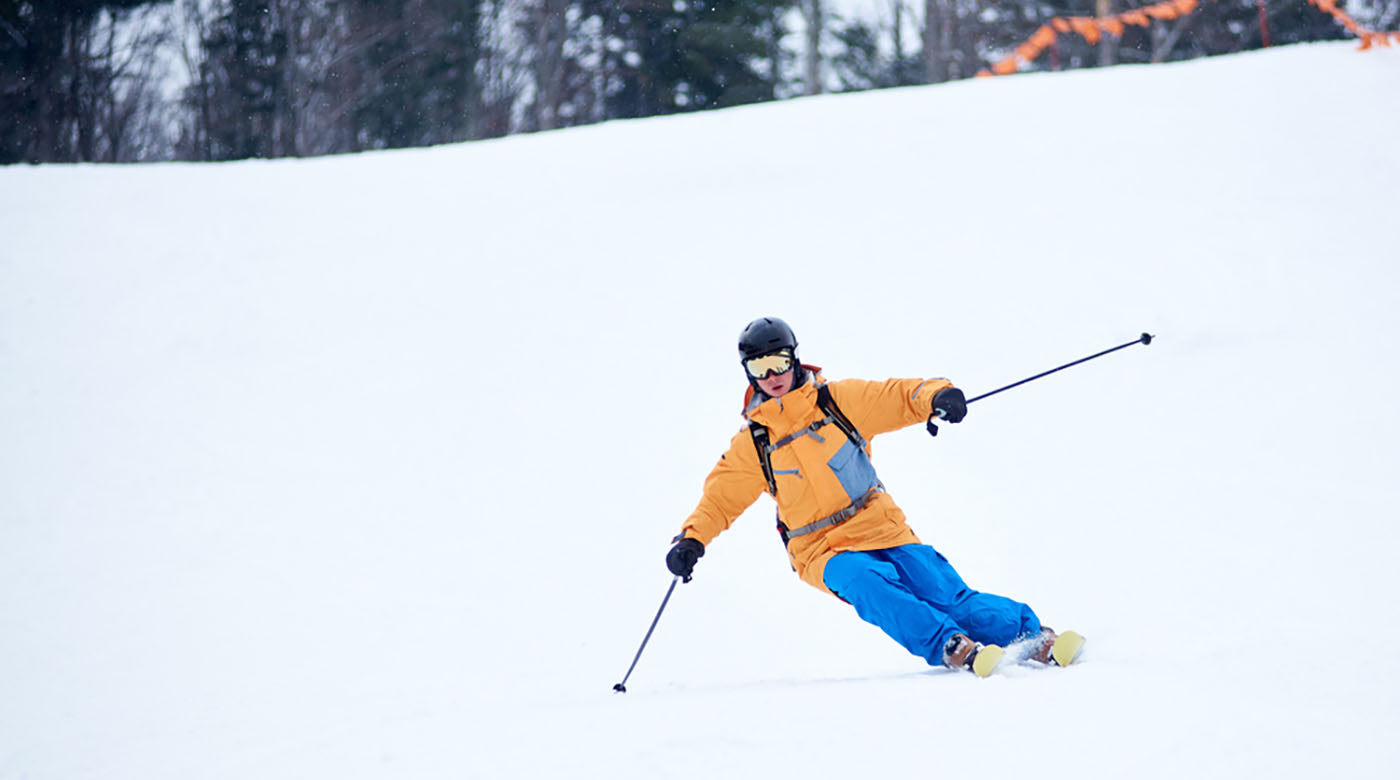Carving ist wie eine parallele „Einpark-Drehung“ auf Skiern. Es ist eine fließende, glanzvolle Bewegung, die sich auf der Piste großartig macht und die Zuschauer fasziniert. Profis schlängeln sich beim Abfahrtslauf nahtlos in S-förmigen Spiralen um Hügel und Hindernisse herum,. Das Carven beim Skifahren zu lernen, erfordert Präzision und Balance – die Beherrschung hängt von der Art der Skier ab und davon, wann und wie Sie Ihren Körper dem Kurvenverlauf anpassen.
Wann man beim Skifahren carven sollte
Anstatt in eine Kurve zu drehen, zu gleiten, zu springen oder zu rutschen, lehnt sich der Fahrer beim Ski-Carving vor und zurück, um eine Kurve einzuleiten und zu kontrollieren, während er zu Tal fährt. Diese Technik verwendet man oft bei Alpin- und Buckelpistenabfahrten, um Hindernissen auszuweichen. Der hochgezogene Mittelteil der Skier, die sogenannte Kante, taucht während der Kurvenfahrt in den Schnee ein und bahnt sich einen Weg. Informieren Sie sich über die verschiedenen Arten des Skifahrens, um zu erfahren, wo Carving-Techniken am hilfreichsten sind.
Sie brauchen viel Platz zum Manövrieren, wenn Sie Ihren Bogenschwung üben. Suchen Sie sich einen mittelschweren Hügel oder einen Anfängerhügel mit leichtem Gefälle und Pulverschnee, der nicht zu glatt oder zu weich ist. Er sollte stabil genug sein, um die Kante zu stützen, und formbar genug, um an den Skiern zu haften, aber nicht zu pulvrig, damit die Kanten nicht stecken bleiben. Vermeiden Sie es, auf verkehrsreichen Pisten zu üben, damit Sie nicht mit jemandem zusammenstoßen, der hinter Ihnen auftaucht.

Ski-Carving-Ausrüstung
Nicht alle Skier sind zum Carven geeignet. Sie brauchen ein Paar mit längeren Kanten oder sogenannte Camber-Skier, um beim Drehen mehr Kontakt mit dem Schnee zu haben. Der „Sidecut-Radius“, also die gebogene Kurve an der Seite Ihrer Skier, beeinflusst die Schärfe Ihrer Kurven. Schärfen Sie die Kanten und entfernen Sie kleine Unebenheiten mit einer Feile, um den Schnee schnell zu durchschneiden. Sie brauchen Ihre Skier nicht unbedingt auszutauschen, um zu carven. Alle Abfahrtsskier haben eine gewisse Wölbung und einen Sidecut, so dass Sie das Drehen üben können, auch vielleicht breiter, als Sie es vielleicht bevorzugen.
Tragen Sie einen Vollvisierhelm, um Kopf und Hals vor Stürzen zu schützen. Wenn Sie sich zu weit oder zu schnell in die Kurve lehnen, können Sie im Schnee begraben werden. Ziehen Sie eine wasserdichte Schicht von Kopf bis Fuß an, damit Sie dann wieder aufstehen können, ohne sich Sorgen zu machen, dass Ihnen zu kalt wird. Tragen Sie eng anliegende Stiefel, die schnell auf Kurven reagieren, um optimale Präzision und Kontrolle zu gewährleisten. Ihre Füße sollten nicht darin herumrutschen, und die Skier sollten sich wie eine Verlängerung Ihrer Füße anfühlen.
Ein Trainer oder Begleiter kann Ihnen helfen, Ihr Timing zu perfektionieren. Koppeln Sie Ihren Helm mit einem Kommunikationsgerät für Skihelme, um mit einem anderen Skifahrer zu sprechen, ohne die Hände von den Stöcken zu nehmen oder laut schreien zu müssen. Wenn er hinter Ihnen herfährt, kann er Ihren Winkel und Ihren Ansatz in Echtzeit analysieren, sodass Sie sich entsprechend darauf einstellen können.
Wenn Sie das Cardo Packtalk Outdoor verwenden, können Sie mit der Dynamic Mesh Technologie bis zu 15 Fahrer gleichzeitig verbinden. Es schafft eine direkte Verbindung zwischen den einzelnen Geräten, sodass Sie mit jedem innerhalb der Reichweite in Kontakt bleiben, auch wenn jemand aus der Formation herausfällt.
Testen Sie das Cardo Packtalk Outdoor bei Ihrer nächsten AbfahrtDie drei Phasen des Carvens
Um Ihre Carving-Fähigkeiten zu verfeinern, haben wir diese Bewegung in drei separate Phasen unterteilt:
Drehen
Starten Sie mit schulterbreit auseinander stehenden Skiern, leicht gebeugten Knien und nach vorne in die Bindungen gepressten Füßen. Halten Sie Ihre Körpermitte angespannt, und achten Sie auf Ihre Haltung.
Leiten Sie die Kurve ein, indem Sie ein Knie in die Richtung beugen, in die Sie fahren möchten. Wenn Sie z. B. nach links abbiegen möchten, rollen Sie Ihr linkes Knie und Ihren linken Knöchel nach vorne und links, sodass die Kante Ihrer Skier in den Schnee schneidet.
Formen
Drücken Sie mit Ihrem Knie nach unten in den Schnee. Je mehr Kraft Sie dabei aufwenden, desto leichter fällt Ihnen die Drehung. Lassen Sie Ihre Knie sich in diese Richtung bewegen, wobei sich Ihr Oberkörper leicht in die Kurve neigt, aber oberhalb der Hüfte stabil bleibt. Bei einer geschwungenen Kante führt der Sidecut Sie nach links.
Beenden
Während die Knie noch immer nach links gebeugt sind, strecken Sie die Beine durch, ohne die Knie zu blockieren, und bringen Sie sie unter die Taille, um die herausgelehnte Haltung zu verlassen. Wenn Sie in die Ausgangsposition zurückkehren, bewegen Sie sich wieder geradeaus.
Üben Sie, nahtlos von einer Linksdrehung in eine Rechtsdrehung überzugehen, sobald Sie wieder eine neutrale Haltung einnehmen.

Um das Carven zu lernen, braucht man freies Gelände mit viel Platz für Fehler. Je mehr Sie Ihre Routine perfektionieren, desto schneller können Sie sich zwischen Hindernissen hindurchschlängeln – das hilft Ihnen, anspruchsvollere Abfahrten zu bewältigen. Wenn Sie auf dem Rücken landen, passen Sie Ihr Timing und Ihre Körperposition an, um zentriert zu bleiben, ohne sich zu weit nach rechts oder links zu neigen. Suchen Sie nach einem Hang in Ihrer Nähe, um diese wichtige Fähigkeit zu üben.





